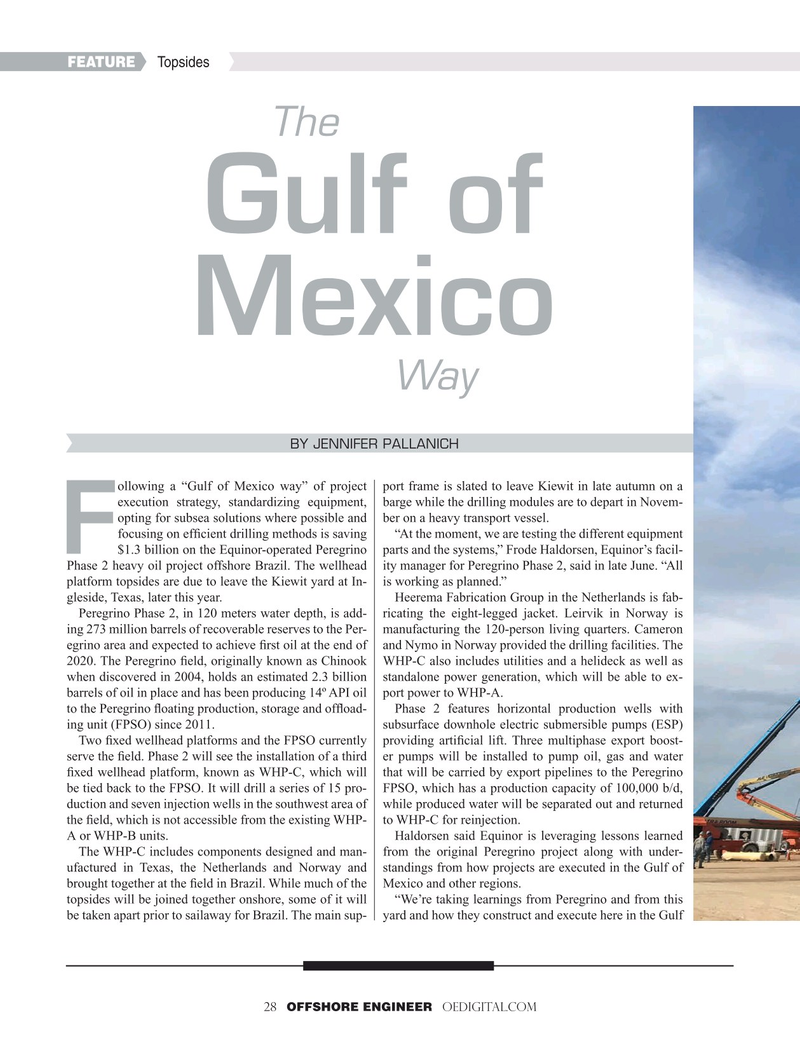
Page 28: of Offshore Engineer Magazine (Jul/Aug 2019)
Subsea Processing
Read this page in Pdf, Flash or Html5 edition of Jul/Aug 2019 Offshore Engineer Magazine
FEATURE Topsides
The
Gulf of
Mexico
Way
BY JENNIFER PALLANICH ollowing a “Gulf of Mexico way” of project port frame is slated to leave Kiewit in late autumn on a execution strategy, standardizing equipment, barge while the drilling modules are to depart in Novem- opting for subsea solutions where possible and ber on a heavy transport vessel. focusing on ef? cient drilling methods is saving “At the moment, we are testing the different equipment
F$1.3 billion on the Equinor-operated Peregrino parts and the systems,” Frode Haldorsen, Equinor’s facil-
Phase 2 heavy oil project offshore Brazil. The wellhead ity manager for Peregrino Phase 2, said in late June. “All platform topsides are due to leave the Kiewit yard at In- is working as planned.” gleside, Texas, later this year. Heerema Fabrication Group in the Netherlands is fab-
Peregrino Phase 2, in 120 meters water depth, is add- ricating the eight-legged jacket. Leirvik in Norway is ing 273 million barrels of recoverable reserves to the Per- manufacturing the 120-person living quarters. Cameron egrino area and expected to achieve ? rst oil at the end of and Nymo in Norway provided the drilling facilities. The 2020. The Peregrino ? eld, originally known as Chinook WHP-C also includes utilities and a helideck as well as when discovered in 2004, holds an estimated 2.3 billion standalone power generation, which will be able to ex- barrels of oil in place and has been producing 14º API oil port power to WHP-A. to the Peregrino ? oating production, storage and of? oad- Phase 2 features horizontal production wells with ing unit (FPSO) since 2011. subsurface downhole electric submersible pumps (ESP)
Two ? xed wellhead platforms and the FPSO currently providing arti? cial lift. Three multiphase export boost- serve the ? eld. Phase 2 will see the installation of a third er pumps will be installed to pump oil, gas and water ? xed wellhead platform, known as WHP-C, which will that will be carried by export pipelines to the Peregrino be tied back to the FPSO. It will drill a series of 15 pro- FPSO, which has a production capacity of 100,000 b/d, duction and seven injection wells in the southwest area of while produced water will be separated out and returned the ? eld, which is not accessible from the existing WHP- to WHP-C for reinjection.
A or WHP-B units. Haldorsen said Equinor is leveraging lessons learned
The WHP-C includes components designed and man- from the original Peregrino project along with under- ufactured in Texas, the Netherlands and Norway and standings from how projects are executed in the Gulf of brought together at the ? eld in Brazil. While much of the Mexico and other regions.
topsides will be joined together onshore, some of it will “We’re taking learnings from Peregrino and from this be taken apart prior to sailaway for Brazil. The main sup- yard and how they construct and execute here in the Gulf 28 OFFSHORE ENGINEER OEDIGITAL.COM

 27
27

 29
29